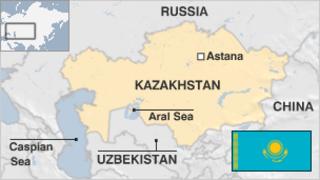Kazakhstan profile
A huge country the size of Western Europe, Kazakhstan has vast mineral resources and enormous economic potential.
The varied landscape stretches from the mountainous, heavily populated regions of the east to the sparsely populated, energy-rich lowlands in the west, and from the industrialised north, with its Siberian climate and terrain, through the arid, empty steppes of the centre, to the fertile south.
Ethnically the former Soviet republic is as diverse, with the Kazakhs making up nearly two thirds of the population, ethnic Russians just under a quarter, and smaller minorities the rest. Suppressed under Soviet rule, the main religion, Islam, is undergoing a revival.
Since independence following the collapse of the Soviet Union in 1991, major investment in the oil sector has brought rapid economic growth, and eased some of the start disparities in wealth of the 1990s.
FACTS
Republic of Kazakhstan
Capital: Astana
Population 18 million (UN, 2012)
Area 2.7 million sq km (1 million sq miles)
Major languages Kazakh, Russian
Major religions Islam, Christianity
Life expectancy 68 years (men), 77 years (women) (UN)
Currency Tenge
LEADERS
President: Nursultan Nazarbayev
Politically, Kazakhstan has been dominated since independence in 1991 by former Communist Party chief Nursultan Nazarbayev, whose long authoritarian rule has faced few challenges from weak opposition parties.
Born in 1940, Mr Nazarbayev came to power in 1989 as first secretary of the Communist Party of Kazakhstan and was elected president the following year. He was re-elected after the break-up of the Soviet Union in 1991, and since then another four times – practically unopposed – most recently in 2015.
He remains popular among many ordinary Kazakhs. His supporters say he preserved inter-ethnic accord and stability during the reform in the 1990s, and is widely credited for the country’s impressive economic growth in first decade of the new millennium.
Mr Nazarbayev has concentrated extensive powers in his own hands and is accused by the opposition of suppressing dissent. He says democracy is a long-term goal, but that stability could be at risk if change is too swift.
MEDIA
The media market is dominated by state-owned and pro-government outlets.
TV is the most popular medium. The government operates national networks.
The authorities regularly block websites and access to social media and messaging apps has been cut several times.
TIMELINE
Late 15th century – With the formation of the Kazakh khanate, the Kazakhs emerge as a distinct ethnic group, but split into three zhuzes (hordes) twi .
1731-42 – Russia establishes control.
1920 – Kazakhstan becomes an autonomous republic – under the misnomer Kirgizstan – following the 1917 Bolshevik revolution and subsequent civil war in Russia.
1936 – Kazakhstan becomes a full union republic of the USSR.
Late 1920s-1930s – Intensive industrialisation and forced collectivisation, which leads to the deaths of more than one million people from starvation.
1954-62 – About two million people, mainly Russians, move to Kazakhstan during Soviet leader Nikita Khrushchev’s campaign to develop virgin lands, lowing the proportion of ethnic Kazakhs to 30%.
1991 December – Nursultan Nazarbayev wins uncontested presidential elections; Kazakhstan declares independence from the Soviet Union.
2011 December – Clashes between striking workers and police in western oil town of Zhanaozen leave 16 people dead.
Source: Read Full Article



